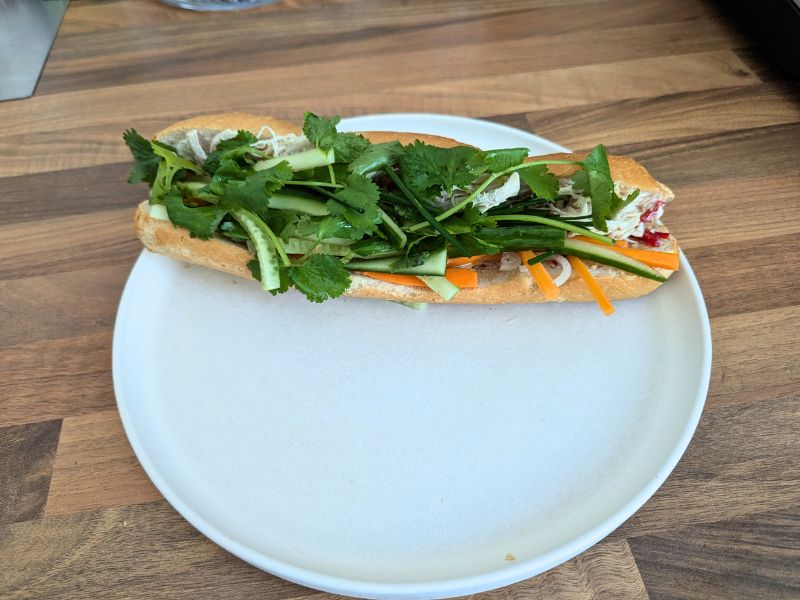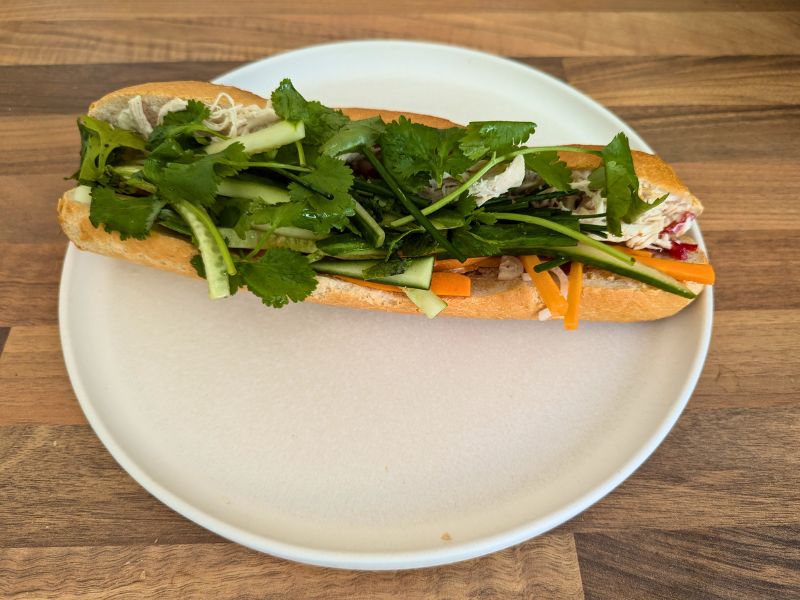Bánh mì, Vietnam’s beloved sandwich, has become a global culinary sensation. This comprehensive guide explores its fascinating history, authentic recipe, and cultural importance, allowing you to experience this street food favourite at home or abroad.
What is Bánh Mì?
Bánh mì is a Vietnamese sandwich that perfectly balances flavours and textures. It features a crispy baguette filled with savoury meats, tangy pickled vegetables, creamy pâté, and fresh herbs, creating an unforgettable taste experience.
The Rich History and Cultural Fusion Behind Bánh Mì
The story of bánh mì begins in the late 19th century during French colonial rule in Vietnam (1859-1954). The French introduced wheat flour and baguettes to Vietnam, where rice had been the staple grain for centuries. These baguettes, initially called bánh tây (western-style bread), were enjoyed mainly by the French colonists and wealthy Vietnamese.
The exact origins of bánh mì as we know it today are somewhat contested, but most food historians credit its creation to Hỏa Lò, a street in Hanoi, in the 1950s. The Lê family, owners of a small bánh mì shop, are often credited with creating the first version of the modern bánh mì.
Key historical milestones:
- 1859-1954: French colonial period introduces baguettes and pâté to Vietnam.
- 1950s: The Lê family in Hanoi begins selling the first recognisable bánh mì sandwiches.
- 1954-1975: After the partition of Vietnam, bánh mì spreads to the south, where it evolves with regional ingredients.
- 1975 onwards: Following the Vietnam War, Vietnamese refugees introduce bánh mì to other countries, leading to its global popularity.
The sandwich evolved as a creative solution to postwar food shortages. Vietnamese bakers began making baguettes with rice flour mixed with wheat flour, resulting in a lighter, crispier bread. Local ingredients replaced expensive imported meats, leading to the diverse fillings we see today.
Bánh mì’s popularity soared due to its affordability, portability, and delicious taste. It became a staple food for workers and students, often eaten for breakfast or as a quick lunch. Today, bánh mì symbolises the fusion of French and Vietnamese cuisines, reflecting Vietnam’s complex colonial history and culinary innovation.
Key Elements of Bánh Mì:

- Crispy baguette
- Savoury meats (often pork or chicken)
- Creamy pâté and mayonnaise
- Tangy pickled vegetables
- Fresh herbs and cucumber
- Spicy chilli
- Umami-rich seasoning sauce
Authentic Bánh Mì Recipe: A Step-by-Step Guide
Create this iconic sandwich at home with our easy-to-follow recipe. While traditional bánh mì often features pork or a combination of cold cuts, our recipe focuses on a shredded chicken version. This lighter alternative maintains the authentic flavours of bánh mì while offering a different protein option. Feel free to experiment with other fillings like grilled pork, tofu, or beef to discover your favourite combination:

Banh Mi
Equipment
- 1 Knife and chopping board
- 2 Bowl 1 to pickle carrot, 1 to make seasoning sauce
- 1 Tall Frying Pan For the Shredded Chicken
Ingredients
Shredded Chicken
- 125 g Chicken Breast
- 1 tbsp Rapeseed oil
- 200 ml Chicken Stock Enough to poach the chicken
Pickled Carrot
- 1/2 Carrot julienned
- 100 ml Warm Water
- 20 g sugar
- 1 tsp salt
- 50 ml rice wine vinegar
Seasoning sauce:
- ½ tbsp soy sauce
- ¼ tbsp fish sauce
- ½ tsp Worcestershire sauce
- ⅛ tsp sugar
Banh Mi
- 2 long bread rolls preferably baguettes
- 30 g pâté we used foie gras
- 3 tbsp mayonnaise
- ½ cucumber julienned
- 2 spring onions sliced
- 1 red chilli thinly sliced
- 1 Handful fresh coriander
Instructions
Prepare the Ingredients:
- Start by preparing all the fillings. Shred the chicken, pickle the carrot, mix together the seasoning sauce and julienne the cucumber.125 g Chicken Breast, 1 tbsp Rapeseed oil, 200 ml Chicken Stock, 1/2 Carrot, 100 ml Warm Water, 20 g sugar, 1 tsp salt, 50 ml rice wine vinegar, ½ tbsp soy sauce, ¼ tbsp fish sauce, ½ tsp Worcestershire sauce, ½ cucumber, ⅛ tsp sugar
Slice the Baguettes:
- Carefully slice the baguettes lengthwise without cutting all the way through.2 long bread rolls
Spread Pâté and Mayonnaise:
- On one side of the baguette, generously spread the pâté. On the other side, coat it with mayonnaise.30 g pâté, 3 tbsp mayonnaise
Assemble the Sandwich:
- Layer the shredded chicken, pickled carrot, cucumber, spring onions, red chilli, and coriander inside the baguette.2 spring onions, 1 red chilli, 1 Handful fresh coriander
Add the Seasoning Sauce:
- Drizzle the seasoning sauce over the fillings to enhance the flavours.
Serve and Enjoy:
- Your bánh mì is ready to be enjoyed. The sandwich should be crispy on the outside, filled with vibrant, contrasting flavours on the inside.
Cooking Tips from Experience:
- Use a crusty baguette for authentic texture.
- To make the shredded chicken, fry 5 mins each side then poach for 15 mins.
- To make the pickled carrots, mix together water, sugar, salt and rice wine vinegar and marinate cut carrots for at least an hour.
- Balance flavours by adjusting seasoning sauce to taste.
- Experiment with different meats or vegetarian options.



Where to Find Ingredients in the UK:
- Large supermarkets (Tesco, Sainsbury’s, Asda)
- Asian grocery stores (Wing Yip, Longdan)
- Local bakeries for fresh baguettes
- Artisanal delis or online suppliers for speciality items like pâté
Bánh Mì Hotspots: Where to Eat in Vietnam and the UK
Vietnam:
- Bánh Mì Phượng (Hoi An): Anthony Bourdain’s favourite
- Bánh Mì Huỳnh Hoa (Ho Chi Minh City): Local favourite known for generous fillings
- Bánh Mì 25 (Hanoi): Popular spot with various options
UK:
- Bánh Mì Hội An (Hackney): Authentic flavours in the heart of Hackney
- Banh (Hackney): Popular grab a sandwich shop
- Banh Mi Kêu Deli (Soho): Mini-chain with 3 eateries around London
Cultural Significance and Eating Etiquette
Bánh mì represents Vietnam’s ability to adapt foreign influences into something uniquely Vietnamese. When enjoying bánh mì:
- Eat with your hands – it’s street food!
- Expect some mess – the crispy baguette will shower crumbs
- Pair with Vietnamese coffee (cà phê sữa đá) or a light lager for the full experience
Bánh mì varies across Vietnam:
- Northern style: Simpler fillings, often just pork and pickles
- Southern style: More complex, with additional sauces and ingredients
- Popular varieties: Bánh mì thịt nguội (cold cuts), bánh mì xíu mại (pork meatballs)
Conclusion:
Bánh mì embodies the fusion of cultures and flavours that defines Vietnamese cuisine. Whether you’re crafting one at home or sampling it from a street vendor in Hanoi, each bite of bánh mì offers a taste of Vietnam’s rich culinary heritage.


Leave a Reply